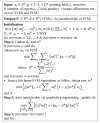Multiple Subtypes of Alzheimer's Disease Base on Brain Atrophy Pattern
- PMID: 33672406
- PMCID: PMC7926857
- DOI: 10.3390/brainsci11020278
Multiple Subtypes of Alzheimer's Disease Base on Brain Atrophy Pattern
Abstract
Alzheimer's disease (AD) is a disease of a heterogeneous nature, which can be disentangled by exploring the characteristics of each AD subtype in the brain structure, neuropathology, and cognition. In this study, a total of 192 AD and 228 cognitively normal (CN) subjects were obtained from the Alzheimer's disease Neuroimaging Initiative database. Based on the cortical thickness patterns, the mixture of experts method (MOE) was applied to the implicit model spectrum of transforms lined with each AD subtype, then their neuropsychological and neuropathological characteristics were analyzed. Furthermore, the piecewise linear classifiers composed of each AD subtype and CN were resolved, and each subtype was comprehensively explained. The following four distinct AD subtypes were discovered: bilateral parietal, frontal, and temporal atrophy AD subtype (occipital sparing AD subtype (OSAD), 29.2%), left temporal dominant atrophy AD subtype (LTAD, 22.4%), minimal atrophy AD subtype (MAD, 16.1%), and diffuse atrophy AD subtype (DAD, 32.3%). These four subtypes display their own characteristics in atrophy pattern, cognition, and neuropathology. Compared with the previous studies, our study found that some AD subjects showed obvious asymmetrical atrophy in left lateral temporal-parietal cortex, OSAD presented the worst cerebrospinal fluid levels, and MAD had the highest proportions of APOE ε4 and APOE ε2. The subtype characteristics were further revealed from the aspect of the model, making it easier for clinicians to understand. The results offer an effective support for individual diagnosis and prognosis.
Keywords: Alzheimer’s disease; atrophy subtypes; cortical thickness; mixture of experts; neuropathology; neuropsychology; structural magnetic resonance imaging.
Conflict of interest statement
The authors declare no conflict of interest.
Figures









Similar articles
-
Concordance of Alzheimer's Disease Subtypes Produced from Different Representative Morphological Measures: A Comparative Study.Brain Sci. 2022 Jan 30;12(2):187. doi: 10.3390/brainsci12020187. Brain Sci. 2022. PMID: 35203950 Free PMC article.
-
Definition and analysis of gray matter atrophy subtypes in mild cognitive impairment based on data-driven methods.Front Aging Neurosci. 2024 Jun 4;16:1328301. doi: 10.3389/fnagi.2024.1328301. eCollection 2024. Front Aging Neurosci. 2024. PMID: 38894849 Free PMC article.
-
A Review of Brain Atrophy Subtypes Definition and Analysis for Alzheimer's Disease Heterogeneity Studies.J Alzheimers Dis. 2021;80(4):1339-1352. doi: 10.3233/JAD-201274. J Alzheimers Dis. 2021. PMID: 33682711 Review.
-
Heterogeneity of Regional Brain Atrophy Patterns Associated with Distinct Progression Rates in Alzheimer's Disease.PLoS One. 2015 Nov 30;10(11):e0142756. doi: 10.1371/journal.pone.0142756. eCollection 2015. PLoS One. 2015. PMID: 26618360 Free PMC article.
-
Biological subtypes of Alzheimer disease: A systematic review and meta-analysis.Neurology. 2020 Mar 10;94(10):436-448. doi: 10.1212/WNL.0000000000009058. Epub 2020 Feb 11. Neurology. 2020. PMID: 32047067 Free PMC article.
Cited by
-
How Many Alzheimer-Perusini's Atypical Forms Do We Still Have to Discover?Biomedicines. 2023 Jul 19;11(7):2035. doi: 10.3390/biomedicines11072035. Biomedicines. 2023. PMID: 37509674 Free PMC article. Review.
-
Altered functional connectivity of primary olfactory cortex-hippocampus-frontal cortex in subjective cognitive decline during odor stimulation.Hum Brain Mapp. 2024 Aug 15;45(12):e26814. doi: 10.1002/hbm.26814. Hum Brain Mapp. 2024. PMID: 39163575 Free PMC article.
-
Recent update on the heterogeneity of the Alzheimer's disease spectrum.J Neural Transm (Vienna). 2022 Jan;129(1):1-24. doi: 10.1007/s00702-021-02449-2. Epub 2021 Dec 17. J Neural Transm (Vienna). 2022. PMID: 34919190 Review.
-
Multimodal subtypes identified in Alzheimer's Disease Neuroimaging Initiative participants by missing-data-enabled subtype and stage inference.Brain Commun. 2024 Jun 25;6(4):fcae219. doi: 10.1093/braincomms/fcae219. eCollection 2024. Brain Commun. 2024. PMID: 39035417 Free PMC article.
-
Concordance of Alzheimer's Disease Subtypes Produced from Different Representative Morphological Measures: A Comparative Study.Brain Sci. 2022 Jan 30;12(2):187. doi: 10.3390/brainsci12020187. Brain Sci. 2022. PMID: 35203950 Free PMC article.
References
-
- Whitwell J.L., Dickson D.W., Murray M.E., Weigand S.D., Tosakulwong N., Senjem M.L., Knopman D.S., Boeve B.F., Parisi J.E., Petersen R.C., et al. Neuroimaging correlates of pathologically defined subtypes of Alzheimer’s disease: A case-control study. Lancet Neurol. 2012;11:868–877. doi: 10.1016/S1474-4422(12)70200-4. - DOI - PMC - PubMed
Grants and funding
LinkOut - more resources
Full Text Sources
Other Literature Sources
Miscellaneous

